Looking for a way to take your push-ups to the next level? Look no further than the T push-up.
It is a challenging and effective exercise for targeting the chest, shoulders, and triceps, and a rotational movement also engages the core.
Whether you’re a beginner or a fitness enthusiast, the T push-up is a great way to add variety to your workout routine.
Get ready to sculpt your upper body and take your fitness to new heights with the T push-up!

- What is T Push Up
- Muscles Worked During T Push Up
- How To Do T Push-Ups
- Sets and Reps
- Tips and Techniques for Doing T Push-Ups
- Variations and Modification of T Push-Up
- 1. Knee T push-up
- 2. Dumbbell T Push up
- 3. T Push Up With Resistance Band
- Benefits of T Push-Up
- How To Incorporate T Push-Ups Into Your Routine
- T Push-Up Alternatives
- Takeaways
What is T Push Up
T push-up is a variation of the traditional push-up that adds a rotational movement. It is a compound exercise that primarily targets the chest, shoulders, and triceps.
The exercise is performed similarly to a traditional push-up. However, with an additional movement, one arm is lifted and rotated out to the side, forming a “T” shape with the body.
It is an effective exercise that can help increase upper body strength, muscle definition, and functional fitness.
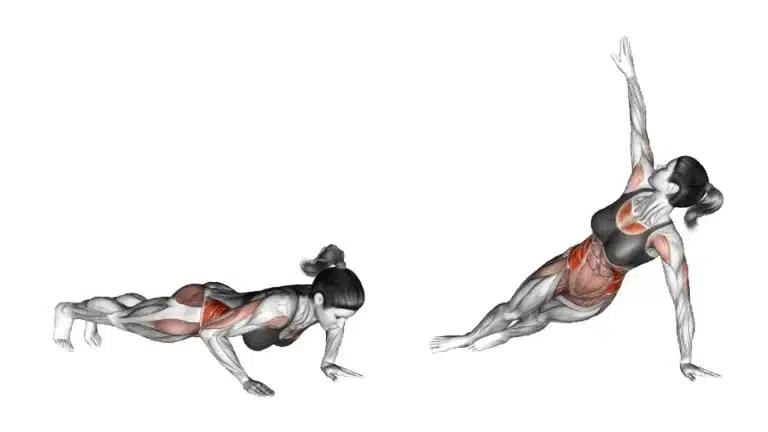
Muscles Worked During T Push Up
The T push-up is a compound exercise that targets multiple muscle groups, including:
- They primarily work the chest muscles (pectoralis major and minor), as well as the triceps and the shoulders (deltoids).
- They also engage the core muscles, serratus anterior as they help to stabilize the body during the exercise.
- Furthermore, it is worth mentioning that the legs and glutes are indirectly targeted during the Push-up-to-t move.
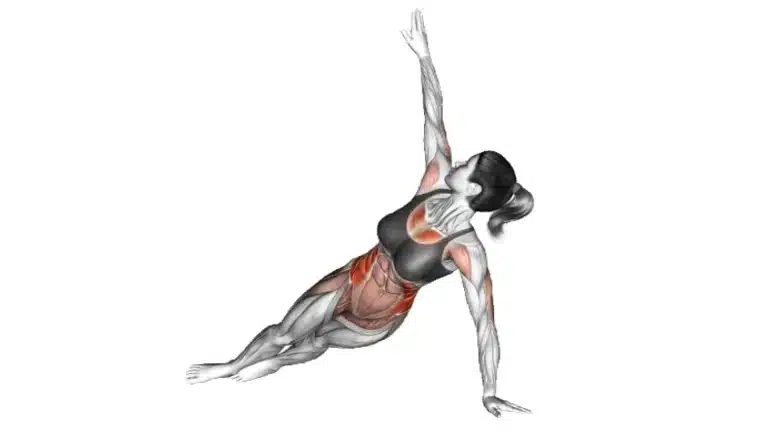
Here’s how these muscles are engaged during the push-up to T:
- Chest muscles: These muscles are responsible for pushing the body up and down.
- Shoulder muscles: They are responsible for lifting the arm and rotating it out to the side, forming the “T” shape. The front, side and rear deltoids are all worked during the exercise.
- Triceps: The triceps are responsible for extending the arm.
- Core muscles: The rotational movement engages the core muscles, which helps to improve overall stability and strengthen the abdominal and oblique muscles.
How To Do T Push-Ups
Here is a step-by-step guide on how to perform the T push-up:
- Start in a traditional push-up position with your hands placed slightly wider than shoulder-width apart and your feet together.
- Lower your body towards the ground, keeping your core engaged and your back straight.
- As you reach the bottom of the push-up, lift one arm off the ground and rotate your body so that your arm is pointing straight up toward the ceiling.
- Your body should now be in the shape of a “T”.
- Hold this position for a moment.
- Then, return your arm to the starting position and repeat the movement on the other side.
- Continue to alternate sides, completing one full push-up each time.

Sets and Reps
The number of sets and reps for T push-ups will depend on your fitness level and goals. Here are some general guidelines:
- Beginners: Start with 2–3 sets of 8–12 reps. Focus on proper form and building strength.
- Intermediate: Aim for 3–4 sets of 12–15 reps.
- Advanced: Aim for 4–5 sets of 15-20 reps or more.
As you become more comfortable with the exercise, you can increase the number of sets and reps.
Tips and Techniques for Doing T Push-Ups
Here are some tips and techniques for doing T push-ups:
- Make sure you start in the traditional push-up position with your hands placed slightly wider than shoulder-width apart.
- Keep your back straight and your core engaged throughout the entire exercise.
- Keep your core tight throughout the entire exercise.
- Avoid rushing through the exercise, and take your time to focus on proper form and engaging the right muscle groups.
- Exhale as you push up, inhale as you rotate your arm.
- As you become more comfortable with the exercise, you can increase the number of sets and reps or add weights or resistance bands to make the exercise more challenging.
- The more you practice it, the more comfortable you will become with the movement. And the more you will be able to increase the difficulty of the exercise.
- Before doing so, it is important to warm up properly. It can be a light cardio or dynamic stretching exercise to get your muscles ready for the workout.
- Don’t Flare your elbow out to the side. This can put unnecessary stress on the shoulder joint and make the exercise less effective.
Variations and Modification of T Push-Up
Variations are a great way to mix up your T push-up routine and keep it fresh.
With a little creativity and variety, you’ll never get bored of mastering this classic move!
Here are some variations and modifications that you can use to make the T push up easier or more challenging, or adapt it to your fitness level.
1. Knee T push-up
Knee T push-up is a variation that is performed on the knees rather than with the feet on the ground.
They are a fantastic stepping stone to mastering full T push-ups. They reduce the amount of bodyweight you are lifting, making it easier for you to learn and perform the movement correctly.
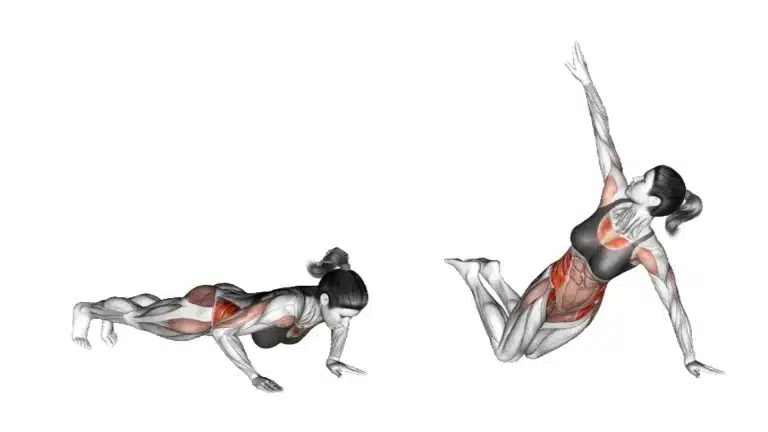
How To Do Knee T Push-Ups
- Start in a traditional push-up position with your knees on the ground.
- Lower your body towards the ground.
- As you reach the bottom of the push-up, lift one arm off the ground and rotate your body so that your arm is pointing straight up toward the ceiling. Your body should now be in the shape of a “T”.
- Hold this position for a moment.
- Then, return your arm to the starting position and repeat the movement on the other side.
- Continue to alternate sides, completing one full knee push-up each time.
2. Dumbbell T Push up
While T push-ups have great benefits, please don’t get stuck doing them forever. Once you’re strong enough, you can progress to regular T push-ups for increased difficulty or try dumbbell variations.
Dumbbell T push-ups involve lifting one hand with a dumbbell off the ground and reaching it towards the ceiling to form a T shape with the body.
Dumbbells provide a neutral grip, which can be more comfortable for those with wrist discomfort.
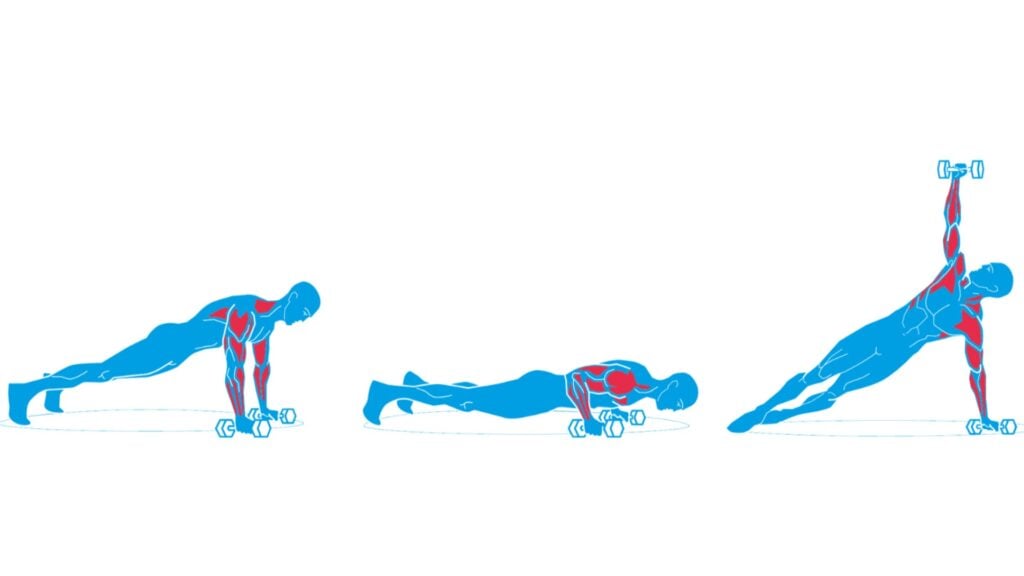
How To Do Dumbbell T Push-Ups
- Grip a dumbbell in each hand.
- Walk your feet back until your body is straight from head to heels.
- Your arms should be fully extended, with your hands on the dumbbells directly under your shoulders.
- Engage your core and keep your body straight as you lower your chest down towards the dumbbells.
- Once your chest touches the dumbbells, press back up to the starting position and lift one hand off the dumbbell.
- Reach the hand towards the ceiling, forming a T shape with your body.
- Lower the hand back down to the dumbbell and repeat the movement on the other side.
3. T Push Up With Resistance Band
T push-up with a resistance band adds extra resistance to the exercise. Using a resistance band increases the challenge to your upper body and engages your core even more.
It’s important to choose the right resistance band for your fitness level.
- You may not get the desired result if the band is too light.
- It can be not easy to maintain proper form if it’s too heavy.
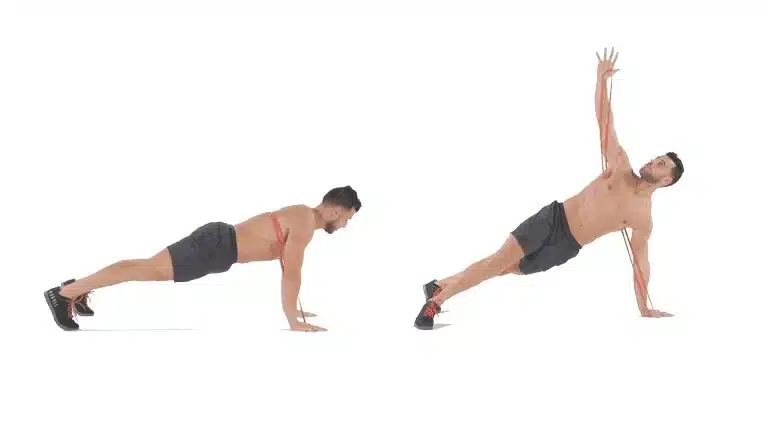
How To Do Resistance Band T Push-Ups
- Place the resistance band around your back and hold the handles with both hands.
- Start in a traditional push-up position.
- Lower your body towards the ground, keeping your core engaged and your back straight.
- At the end of a push-up, lift one arm off the ground and rotate your body so that your arm is pointing straight up toward the ceiling. Your body should now be in the shape of a “T”.
- Hold this position for a moment and then return your arm to the starting position.
- Repeat the movement on the other side.
- Continue to alternate sides.
Benefits of T Push-Up
The T push-up is a great way to add variety to your workout routine and challenge your upper body strength.
- It is a compound exercise that targets the chest, shoulders, and triceps, which helps to increase upper body mass.
- The rotational movement of the T push-up engages the core muscles.
- It is a full-body exercise that helps to increase functional fitness and improve overall fitness levels.
- It improves upper body strength and stability.
- T push-up improves the stability of the shoulder joint, which can help reduce the risk of injury.
How To Incorporate T Push-Ups Into Your Routine
T push-up is an effective exercise that can be incorporated into your workout routine.
Here are some ways to incorporate it into your workout routine:
- As a standalone exercise: It can be done as a standalone exercise, adding 2–3 sets of 8–12 reps to your bodyweight workout routine.
- As a finisher: T push-up can be added as a finisher at the end of your workout, adding 2–3 sets of 8–12 reps.
- Incorporate it into your push-up routine: Incorporate it into your regular push-up routine.
- Add it to your upper body workout: Incorporate it into your upper body workout, adding 3–4 sets of 8–15 reps.
- Incorporate it into your circuit training: Incorporate it into your circuit training in between other exercises like pull-ups, rows, etc.
T Push-Up Alternatives
Here are some alternatives exercises to the T push-up that target similar muscle groups:
- Incline push-up
- Plank rotations
- Close-Grip Push-Up
- Dumbbell pullover
- One-Arm Push-up
- Y-T-I Raises
- Chest Fly Variations
Takeaways
T push-ups provide a fantastic full-body workout, simultaneously hitting your chest, shoulders, triceps, and core.
Focusing on proper form, practicing regularly, and increasing resistance is important to get the most out of this exercise.
Ready to give T push-ups a try? Start with a few sets and focus on nailing your form.
In the comments, please let us know how it goes!
References
- Ebben WP, Wurm B, VanderZanden TL, Spadavecchia ML, Durocher JJ, Bickham CT, Petushek EJ. Kinetic analysis of several variations of push-ups. The Journal of Strength & Conditioning Research. 2011 Oct 1;25(10):2891-4.
- Cogley RM, Archambault TA, Fibeger JF, Koverman MM, Youdas JW, Hollman JH. Comparison of muscle activation using various hand positions during the push-up exercise. J Strength Cond Res. 2005 Aug;19(3):628-33. doi: 10.1519/15094.1. PMID: 16095413.

Manish is a NASM-certified fitness and nutrition coach with over 10 years of experience in weight lifting and fat loss fitness coaching. He specializes in gym-based training and has a lot of knowledge about exercise, lifting technique, biomechanics, and more.
Through “Fit Life Regime,” he generously shares the insights he’s gained over a decade in the field. His goal is to equip others with the knowledge to start their own fitness journey.
